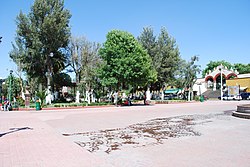Otumba de Gómez Farías
|
Otumba de Gómez Farías Otumba |
|
|---|---|
| Town & Municipality | |

Main plaza
|
|
| Coordinates: 19°41′49″N 98°45′17″W / 19.69694°N 98.75472°WCoordinates: 19°41′49″N 98°45′17″W / 19.69694°N 98.75472°W | |
| Country |
|
| State | State of Mexico |
| Founded | 1200s |
| Municipal Status | 1821 |
| Elevation (of seat) | 2,360 m (7,740 ft) |
| Population (2005) Municipality | |
| • Municipality | 29,873 |
| • Seat | 9,242 |
| Time zone | CST (UTC-6) |
| Postal code (of seat) | 55900 |
| Website |
www |
Otumba or Otumba de Gómez Farías is a town and municipality located in the northeast of the State of Mexico, just northeast of Mexico City. Historically, this area is best known as the site of the Battle of Otumba and as an important crossroads during the colonial period where incoming viceroys ceremoniously were handed power by their predecessors. Today, it is a rural municipality undergoing changes as urbanization arrives here from the Mexico City area. However, one element from the past that is still remembered is that of burros or donkeys. During the colonial period, Otumba was an important market for the animals, and they are still culturally important. Each year, the municipality sponsors a Feria de Burros or Donkey Fair, where the animals star in fashion shows, costume contests, and races. There is also a donkey sanctuary for unwanted animals.
The name Otumba comes from Nahuatl and means "place of otomis." The appendage "Gómez Farías" was added in honor of Valentín Gómez Farías. The Aztec glyph for the area depicts an Otomi character with the sign meaning place. The municipality is represented by this glyph and by a Spanish coat of arms.
This area was most likely settled by the Otomi although it is said that these Otomi descended from the Chichimeca. A series of villages were established in this area in the Classic period between 200 and 900 AD with the first known ruler being Motolina. When the chiefdom of fell in 1200, many other Otomis came to take refuge here, founding the town.
The area came under the rule of Azcapotzalco during the reign of Tezozomoc. Aztec rule was established here by Nezahualcoyotl from Texcoco, who made Otumba a regional capital, serving as a point of collection for tribute. As an Aztec city, it contained a sacred plaza with a temple and perhaps a lord's palace. Outside this plaza area was the residential area for the elite called the pipiltin, consisting of large houses occupied by extended families. There was probably also a central market. Outside of that was a second residential zone for the common population, called the macehualtin. The organization of the city reflected that of Texcoco but at a smaller scale. There is evidence that this city produced crafts such as ceramics on a large scale.
...
Wikipedia

